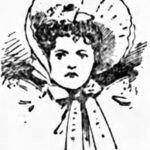The First World War began in 1914 when Austria-Hungary declared war on Serbia following the assassination of Austrian Archduke Franz Ferdinand and his wife, Sophie, on June 28, 1914.
Shortly before Italy signed the Treaty of London on April 26, 1915, committing itself to enter the war on the Allies’ side, the brutal murder of a child sent shockwaves throughout London. The abduction and murder happened in a city crawling with home defense soldiers whose job was to protect the citizens during the war, not to mention many Metropolitan Police officers also patrolling the streets.
Despite the chaos stemming from the war, parents would send a child on errands and allow them to walk to other places alone. The time was a far cry from today. Parents likely felt the city was safer now than ever until the murder shattered their sense of security.
Margaret “Maggie” Nalley, 7, resided with her family on Amberley Road, Paddington. Maggie was one of four children and a student at All Angels School on Cirencester Street.
Maggie was an independent and intelligent little girl who often walked alone in London to visit relatives.
On Easter Sunday, April 4, 1915, she left home at 3:30 p.m. to walk to her aunt’s at Carlisle Street and Edgware Road.
At 5:15 p.m., Maggie reportedly visited her uncle, Private Hoard of the London Rifle Brigade (LRB), who resided on Richmond Street, Marylebone. Maggie was alone and stayed for a few minutes. She then went out to get a few things for her uncle’s wife, returned, then left again, saying she would visit her aunt, Bethy Scott, who was Maggie’s aunt by marriage – she was married to Maggie’s paternal uncle. That was the last time her uncle saw Maggie.
The Scotts resided at 112 Carlisle Street. Mrs. Scott had taken Bethy’s daughter, Alice Mary Scott, 5, to John’s home, and when she and Alice returned to their residence at 4:20 p.m., Maggie was waiting for them.
“Your father is up at granddad’s. Are you going to go up there?” Mrs. Scott asked Maggie.
Maggie’s grandfather, John Nally, resided at 71 Carlisle Street, Marylebone.
She came to see me between four and half past on Sunday afternoon, but she did not stop long. She said she was going to see her aunt, who lives further up the road. The last time I saw her was just before dusk when she came to see if her uncle was there. She simply came to the door but did not come in. As her uncle was not here, she went back to her aunt’s, and I understand she was seen playing with other children at the corner of the street at 8 o’clock. She would go home down Church street, along Edgware-road and Maida-vale, down Clifton-road, and into Warwick-avenue, and thence into Formosa-street. She was always told not to go along the side of the canal. She was very intelligent at school and intensely interested in books. When she came to see me, she usually turned over all my books and papers to see if there were any pictures. Before she left me on Sunday afternoon, I gave her a halfpenny to buy some sweets.
John Nally, Daily Mail, April 6, 1915
Maggie had asked Alice to go to John’s home, but Alice had just returned. “Granddad has given me a penny,” Alice said.
Alice asked her mother, “Shall I give Margaret a farthing?” Her mother said yes. The two little girls then went to Mr. Knight’s shop at the corner of Richmond and Carlisle Streets and bought some mixed sweets.
Mrs. Scott saw Maggie again at 7:30 p.m. in the street and asked her to return to the shop to buy some matches. When Maggie returned, Mrs. Scott lit the gas, and the girls played on the piano. But the girls banging on the piano keys drove Bethy mad because she had a splitting headache.
“Do leave off. My head is aching,” she told the girls. Bethy gave them a penny, and they once again went to Mr. Knight’s shop to buy more sweets.
At 8 p.m., Alice returned home alone, telling Mrs. Scott, “Maggie has gone home.” At 9:15 p.m., Maggie’s father, John Henry Nally, went to the Scott home at 9:15 p.m. looking for his daughter when she never returned home. He began searching for Maggie but did not find her.
At 11:53 p.m. Maggie’s body was found at Aldersgate station, later renamed Barbican. She had been killed “by foul means” and was “terribly maltreated” and “outraged.”
Pathologist Dr. Bernard Spilsbury, who performed the autopsy, found a piece of a 9.5″ x 11″ strip of undervest shoved into her mouth. The killer had used the cloth to stifle her screams and suffocate her.
Spilsbury had examined the stomach contents and found that Maggie had consumed a meal containing meat and fat within 90 minutes of her death.
Police took meat samples from a butcher’s shop near Edgware Road. There was a pub near the shop soldiers had visited at 8 p.m. on the night of Maggie’s death. One refused to drink because he had already consumed enough alcohol.
The police investigation produced several witnesses who had seen the young girl in different parts of London on Easter Sunday evening. A bus conductor saw her with a man on the service between Pound Lande and London Bridge at 8:16 p.m. The two had entered the bus outside Gardner’s on Edgware Road. The man was about 30, dressed in khaki, and appeared to have been drinking.
According to the conductor, “The little girl was between six and eight, with a round face, healthy appearance, dressed in a dark gray coat and without a hat,” reported My London News.
The child was crying and did not want to get on the bus, but the man pushed her up the steps and navigated her to a seat in the back.
The man then headed to the front of the bus and asked the conductor, “Do you go to the Cross (King’s Cross)?” The conductor said yes and told the man it would cost “three halfpence each.” The man purchased two tickets, and the conductor punched them and handed them to the man. Some reports say the man was a soldier.
Another witness, Edward Spencer, saw a woman with a child on Easter Sunday in the booking hall at Aldersgate Station. Spencer was a porter there.
A soldier said he found Maggie’s hat in a movie theater on the night of her murder. The soldier had been on leave in London. He said he was at the Grand Cinema on Easter Sunday at 9 p.m. The theater was about a quarter of a mile from where Maggie was last seen alive.
There were two empty seats in front of him and a hat in one of them. The hat was similar to Maggie’s hat. When Maggie vanished, she wore a gray-blue felt hat trimmed with white ball flowers.
The soldier said he picked up the hat and wore it for about 10 minutes, joking around. He then tossed it to some girls who were sitting nearby. Police arrived at the cinema to look for the hat but never found it.
The investigation into Maggie’s murder faded. Then, in March 1916, a man was held by Manchester Police in connection with Maggie’s murder. However, once London investigators saw him, they did not believe he was the killer and never solved Maggie’s murder.
True Crime Diva’s Thoughts
Maggie’s mother stated after her death, “I cannot understand how anyone could have enticed her away because I had always warned her about following or going with strange men, and I am sure she would do what I had told her to.”
But if Maggie KNEW the man, that would be a different story, so I wonder if she did.
One source reported that Alice had seen Maggie with a man she described as old, which to a 5-year-old could have been anyone over 20 lol.
Sadly, a child killer got away with this horrific crime. He likely killed before and after Maggie.
I found an eerily similar crime in East Ham, London. Bertha Endricka Russ, 6, vanished on Feb. 19, 1899. That day was also a Sunday. She left home at 2 p.m. and attended the school attached to St. Barnabas Church. After school ended at 4 p.m., the superintendent asked her if she would stay for a christening ceremony, but she said she wanted to return home to her mother.
Witnesses saw her walking to Byron Avenue but then turned around toward the school. Two ladies saw her at the school’s gate, but it was shut, and she started crying. A man about 18 approached Bertha and spoke with her. He then walked toward Shelley Avenue. Bertha continued crying, ran toward Shelley Avenue, and “overtook the man,” The People newspaper reported. Bertha and the man then walked off together.
The women did not get a good look at the man’s face, but they said he wore a brown cap, coat, and dark trousers.
Two weeks later, on Sunday, March 5, 1899, a couple looking at a recently built home opened a long cupboard and discovered Bertha dead inside in a seated position. The house was more than a mile from Bertha’s home and the Sunday School.
Bertha had suffocated to death when the killer placed a soft cloth over her mouth. Police never solved her case either.
The man seen with Bertha would be in the age group of Maggie’s killer. He would have been in his 30s in 1915. I doubt the crimes are related, but it’s worth mentioning Bertha’s murder. Bertha likely knew the young man she followed, and the doctor who did the post-mortem did not believe she had been sexually assaulted.
Shortly before Bertha’s murder, Mary Jane Voller, 5, was brutally killed in Barking, London, adjacent to East Ham. The young girl’s mother sent her to a nearby shop shortly after 5 p.m. on New Year’s Eve in 1898. Mary’s father found her body in a flooded ditch later that evening. Her throat had been cut. Her case remains unsolved, too.
A few hours before her death, Mary told her mother she had a bad dream the night before. In the dream, a man came to get her. Her mother later told her she “must not scream in bed.” Maggie replied, “When I’m in bed, there is always a man under it, and he wakes me up.”
Some believe that a Jack the Ripper copycat may have been responsible for Bertha and Mary’s murders and other child murders during that time, according to London tabloids.
Additional Sources: Unsolved-Murders.co.uk and historical newspapers articles from Daily Mail, The Standard, and Lloyd’s Weekly Newspaper via Newspapers.com. The original image of Maggie is located here.




